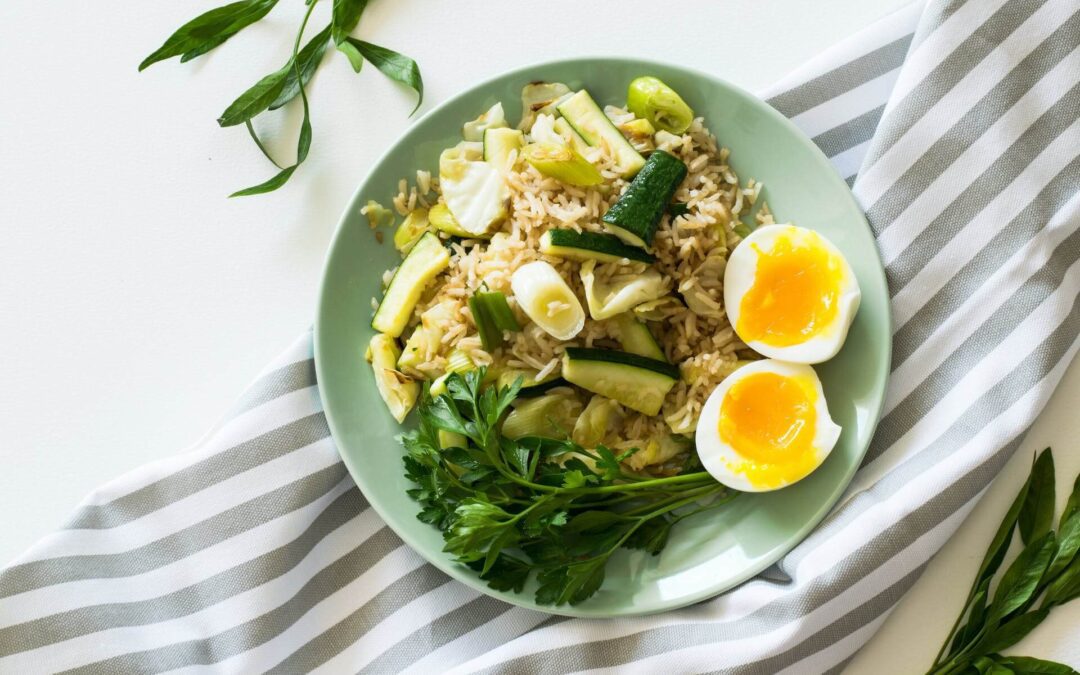My second passion, after travel, is food.
I feel connected to another culture when I can immerse myself in it by eating its traditional dishes.
Growing up in Trinidad and Tobago (“Trinbago”), my relationship with food was inevitably diversified. Trinbago’s food is a veritable melting pot, with English, French, and Spanish colonial influences and eating habits from Africa, East India, China, and now Venezuela.
However, most of my official nutrition education has centered on the food pyramid and, more recently, the United States Department of Agriculture’s (USDA) MyPlate guide – notions that do not correspond with many traditional meals.
While MyPlate suggests that a balanced plate should consist of half non-starchy vegetables, one-quarter protein, and one-quarter grains, traditional one-pot recipes combine these dietary categories into a meal that cannot be portioned on a plate.
For example, serving pelau — a Caribbean one-pot dish cooked with caramelized chicken, parboiled rice, pigeon peas, and an assortment of vegetables and seasonings — inside the MyPlate framework is unrealistic.
As a nutritionist and food enthusiast, I got perplexed and upset while attempting to provide culturally appropriate nutritious meals.
“Are these traditional meals genuinely healthy if they don’t match the MyPlate model, or does the accepted Western idea of healthy, balanced meals lack cultural competence?” I wondered.
It wasn’t until recently that I was able to construct a healthy eating paradigm that incorporates the intricacies of cultural cuisines and inclusion.
I’ll take you along for some of the rides and show you what I discovered.
Bridging the gap between nutritional science and traditional cuisine
Although I didn’t know what to call it at the time, my interest in nutrition began at seven, following my mother’s stroke, when I was inspired to use food as medicine to enhance her quality of life.
However, it wasn’t until I started working as a dietetic technician that I realized I had a love for teaching people about the role nutrition plays in managing their medical problems.
These client education seminars in Trinidad and Tobago focused on healthy ways to enjoy local meals, such as choosing the high fiber dhalpuri roti — a classic flatbread — over its high fat equivalent, paratha roti.
I witnessed dietitians and their clients struggle to negotiate acceptable food alternatives that respected the client’s culinary culture while interning in the United States. This gap may jeopardize the client’s adherence to their dietary plan and overall success.
I seek to diversify nutrition education for individuals to obtain better health outcomes without renouncing their food traditions.
My daily approach to nutrition — both struggles and triumphs
In my everyday existence, I approach a diet with flexibility.
Most meals are balanced, consisting of grain, protein, and veggies or fruit. I incorporate regional or local dishes, and I adore treats!
Fortunately, many healthful, traditional dishes simplify meal planning, such as sautéed spinach with taro root and stewed fish.
When it comes to one-pot recipes like oil down — a delicious dish cooked with breadfruit, spinach, carrots, and salty meat like pig tails — my focus shifts to portion management, including high fiber side dishes, and mindful eating practices like paying attention to my fullness cues.
My weekly cooking schedule
As someone with thyroid nodules, my energy levels frequently fluctuate, which may impair my capacity to cook dishes.
As a result, I cook 2-3 times weekly, preparing enough food for 1-2 days. On Fridays, I usually order out; on Saturdays, I make bean soup; on Mondays, I consume leftovers from Sunday lunch.
Use minimally processed foods to make meal preparation more accessible and more convenient.
I occasionally buy pre-chopped veggies at the grocery store, but I prefer fresh food at the farmer’s market. When making meals, freezing amounts of seasoned meat, fish, and chopped vegetables saves time, as does use low salt canned products like tuna.
To help my thyroid health even further, I’ve cut less on highly processed convenience meals and shifted my focus to healthy foods.
This means baking everything from scratch at home using unbleached whole wheat flour for most of 2020 and preceding frozen waffles and pancakes.
It also means eating more prebiotic and probiotic foods, such as yogurt, and consuming tiny amounts of fiber at all times to aid digestion, which thyroid issues can hamper.
What are common misconceptions about dietitians?
One common misconception about dietitians is that we all eat the same way.
Most people don’t expect a dietician to eat doubles, a fried, curried, chickpea finger meal from Trinidad and Tobago. They may see anyone who does as setting a bad example or eating “unhealthy” foods.
Doubles, on the other hand, are my all-time favorite. Every mouthful is delicious!
I’d be set for life if I had a dime for every misconception about dietitians. Let us debunk a few:
- Dietitians are not food inspectors. Indeed, many dietitians are adaptable in their eating habits and may advise you to do the same. We’re not here to lecture you about taking a second helping.
- Desserts are also popular among dietitians. Desserts are also on a dietitian’s menu, whether it’s an original dish or a reduced fat variation. (“May I please have another slice of cake?”)
- Dietitians provide benefits to your health that go beyond weight loss. Dietitians are frequently contacted for weight reduction, but they may also educate you on how to use diet to support your medical condition or general health objectives, whether or not you are trying to lose weight.
Current trends in dietetics
Of course, not all dietitians are the same. We provide a wide range of nutritional therapy viewpoints and methodologies. While some swear by calorie monitoring, others teach their clients about food independence and intuitive eating instead.
The dietetics field is currently shifting toward the Health at Every Size (HAES) approach, championed by the Association for Size Diversity and Health.
HAES understands that health is diverse and that, regardless of your body weight, you need medically and nutritionally appropriate knowledge suited to your specific requirements.
Whether you want to consult a dietitian or nutritionist, you should extensively study the specialists in your region to see if you’re a suitable fit.
My favorite foods and go-to meals, snacks, and recipes
I treated homesickness with traditional dishes while studying for a Master’s degree in the United States.
My go-to comfort food is callaloo (puréed spinach, okra, pumpkin, and green spices) with oven-baked chicken and macaroni pie.
When I need a quick dinner or brunch, I make whole grain bread, scrambled eggs or sausages, and sautéed veggies such as broccoli, bok choy, and fruit.
Other foods I adore are the pelau above, oil down, and roti with curried chicken.
In addition to fruit, I enjoy trail mix, dark or milk chocolate, sliced apples with peanut butter, and yogurt as snacks.
I buy tamarind balls (a sweet and spicy delight produced from tamarind fruit), kurma (a crispy flour-based snack with ginger), and benne balls on occasion (made with sesame seeds and molasses).
In addition, I make fresh juices and smoothies at home to consume in the morning.
My go-to juice
My basic fresh juice recipe (serves one) is as follows:
- One small gala apple
- One medium carrot
- Three stalks of celery
- One small beetroot
- 1/4 inch (0.5 cm) of ginger
- One medium cucumber
Juice, pour, and enjoy.
Encouraging healthy eating with a toddler
My 3-year-old kid enjoys cooking (any excuse to play with water, really), and — bonus! — discussing food with him is simple.
He helps us in the kitchen by slicing things, putting stuff into the juicer, stirring the saucepan, and serving the food. He’s also pretty skilled at breaking eggs – no shells!
His first introduction to food quantities and the notion of a balanced plate was through a split plate with illustrations of food groups (similar to this one).
Allowing him to select his fruit, vegetable, grain, and protein offered him agency while keeping him interested in his meal.
Other innovative ways we’ve used include making fruit and vegetable stamps for our at-home arts and crafts sessions and introducing our child to the range of in-season fruits and veggies in Trinidad and Tobago.
His munchies include yogurt, fresh fruit, cookies, chips, chocolate, and occasionally juice.
The realistic side of healthy eating
Dietitians, like everyone else, are human.
However, misunderstandings about my career and healthy eating cause family members to scrutinize me if I nibble on anything other than fruits and vegetables or if my weight climbs somewhat.
This is amusing, but it also demonstrates the mountain of anguish generated by diet culture, which dietitians and nutritionists must address.
I occasionally eat for pleasure and have learned to separate my morals and self-worth from meals. As a result, I can eat without feeling guilty.
This does not imply that I overeat empty-calorie items, but rather that I have found a sweet spot where I can enjoy what I eat while meeting my health objectives — and doing so without becoming obsessed with food.
But, to be clear, healthy eating does not have a distinct appearance. It’s not a simple notion, especially regarding cultural delicacies.
Although Trinidad and Tobago’s traditional one-pot recipes aren’t represented in the USDA’s MyPlate or conventional, Western concepts of balanced meals, they’re nutrient-dense, delicious, and a fantastic match for a healthy diet.
Overall, healthy eating should be based on your personal preferences and likes.







0 Comments